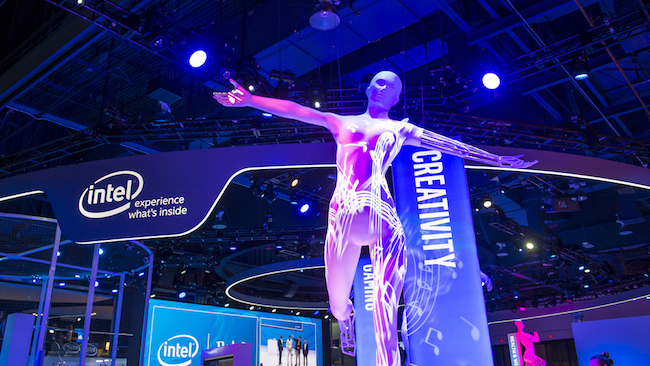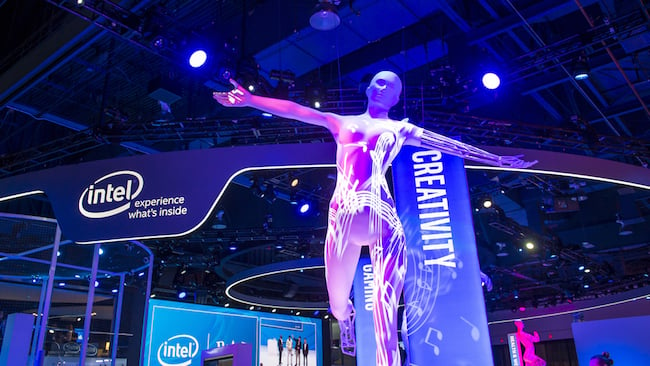
 Embrace the future at CES: Intel's stand at CES 2016
Embrace the future at CES: Intel's stand at CES 2016
The first big event of the year, CES, arrives hot on the heels of the New Year break. David Shapton looks at some of the technologies that may be making an appearance first on the showfloor and then in your living room not long after.
CES, the Las Vegas-based consumer electronics show, wakes us up each year after our post-Christmas lethargy. It’s brutally close to the first day back at work after the break but it’s no bad thing, because it gets us back on our toes for the New Year. Even though the show doesn’t start until January, advance press releases will start coming in this week and we’ll report as soon as we get them.
The exhibition is a really good indicator of consumer trends, and that’s not just for gear junkies and gadget gourmets, but for the whole economic and technology sector because consumer and media electronics are now right at the cutting edge of what’s possible. In previous decades it was thought that military tech was years ahead but that was before consumers became addicted to having a new smart phone every year. And now we expect to be able to talk to our fluffy toys and have them reply while translating into Hungarian. There’s never been a time when advanced technology has been mass produced and marketed with such hopeful relish.
So, what do we expect to see at CES this year?
There will be televisions, and they will be big. There won’t be any HD TVs on show at all: they will all be at least 4K. Some may even be 8K but mostly won’t be for sale in the shops. They'll be eye-wateringly expensive and unless you own a RED camera with a Helium sensor, there won't be any 8K material to watch. But who knows: the 2020 Olympics are getting closer and by then, you can expect quite a few 8K models to be on sale in the lead up to that.
OLED still gives the very best black levels but LCDs are catching up with some clever selective backlighting ideas, so expect to see some developments here. I would be surprised to see any TVs without some degree of HDR capability.
I'd expect to see quite a few cameras and possibly some that are interesting to professionals; some might be variants of Pro models already on sale but with reduced features, or perhaps new models that might be beefed up and touted as Pro devices. Either way, I think the most interesting category right now is hybrid stills and video cameras where you can shoot at 4K or above and easily extract still pictures. This technique is not going to take over from still photography completely but there are times when you simply can't beat it, especially when you're trying desperately to find a single shot that's in focus!
It’s also possible that we’ll see some advances in Light Field photography (and video) and, more generally, computational photography, where instead of a single sense, cameras sport multiple optics and sensors, and a high quality picture is derived from the input of all of them.
Moving away from photography and video: I think it's likely we'll see a lot of vinyl. I never thought I'd say that, and I still believe that a good digital recording beats a vinyl one in every way, but I can't argue against a trend which has, incredibly, led to more vinyl recordings being sold this year than digital downloads [by value - see Roland Denning's comment below], and "LPs" being on sale in supermarkets. We'll see high, mid and low priced turntables, some, ironically with features like Bluetooth (ironic because that's a digital wireless protocol).
There will be Lightning headphones in approximately sixty seven billion new designs. This is because the iPhone has "made progress" by eliminating its most useful and universal connection, the 3.5mm headphone jack. And because it's obviously so much better to frustrate headphone-owners by omitting this essential feature, it looks like Samsung is going to follow suit.
It's not that "digital" headphones are a bad thing - they can be a much better prospect if they have a higher quality DAC than is built in to the phone - but it's still an nuisance that we can't have both. (And don't be surprised if most of the really cheap digital headphones sound terrible because good DACs use expensive components.)
Finally, the category of product that I most expect to see at CES is anything that uses AI. Artificial intelligence is starting to be called the fourth Industrial Revolution. Let's hope it's not also the last one. Meanwhile, all manner of toys, fluffy or otherwise, will now come with some sort of ability to understand you and to reply to you. Some might even teach you something. Some might merely make you laugh. And some might terrify you.
This is just the start for AI consumer products. All the software giants are devoting hallucinogenically large resources into researching and productising AI. It will spread into the consumer ecosystem faster than you'd imagine, because AI will be available as a service from the cloud. There are already AI APIs out there and there will be dozens more soon. For a consumer electronics manufacturer, it will be as simple as putting an internet connection into a device and writing some high-level software.
That's it for now. We'll see whether I'm right over the next three weeks!
CES 2016 picture: shutterstock.com
Tags: Technology


Comments